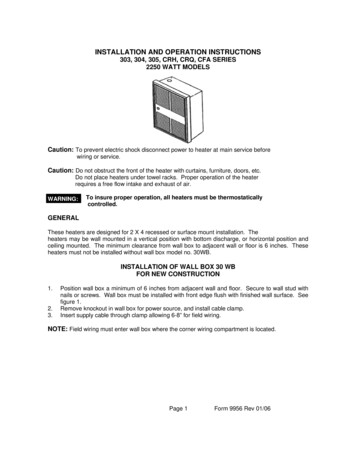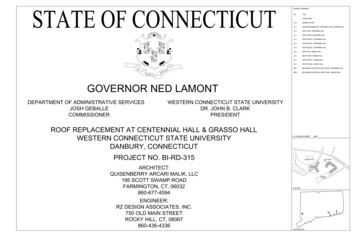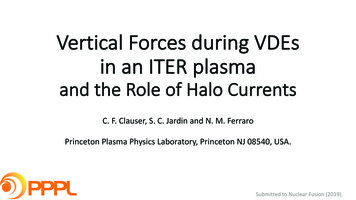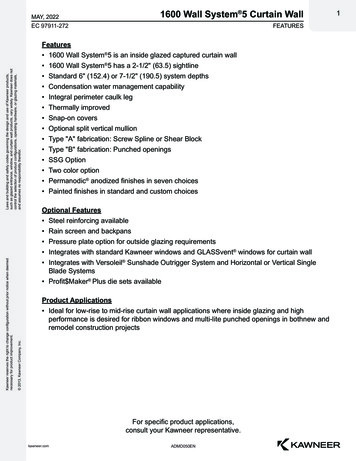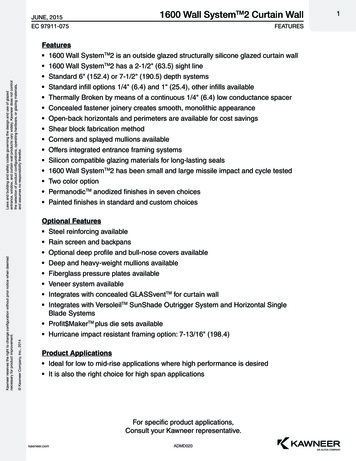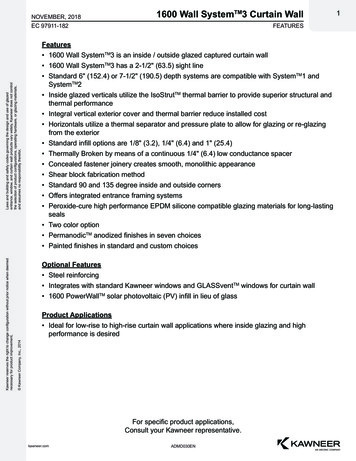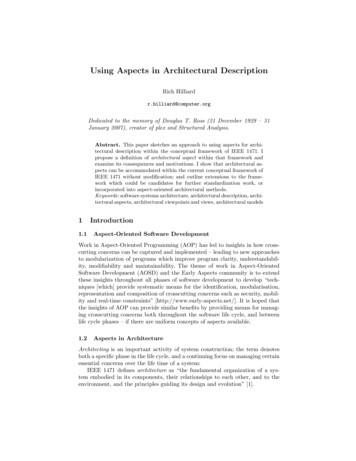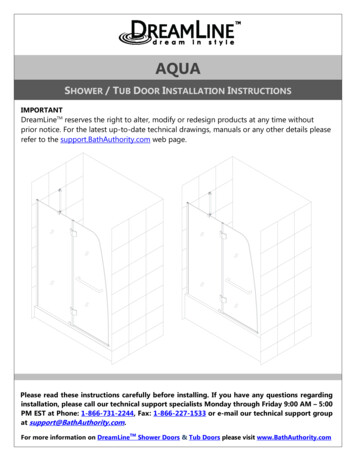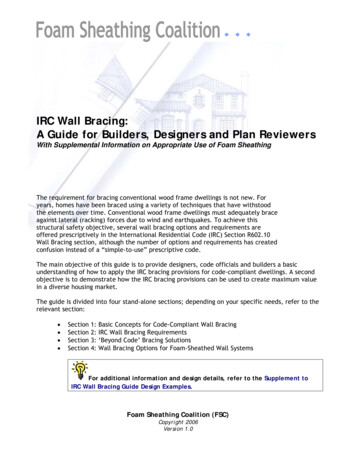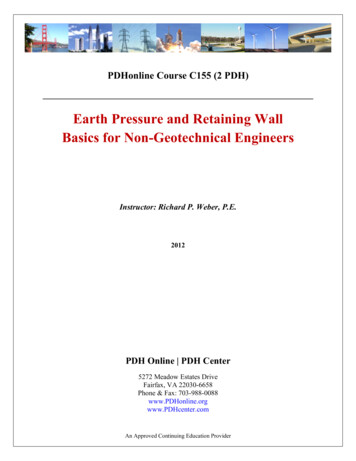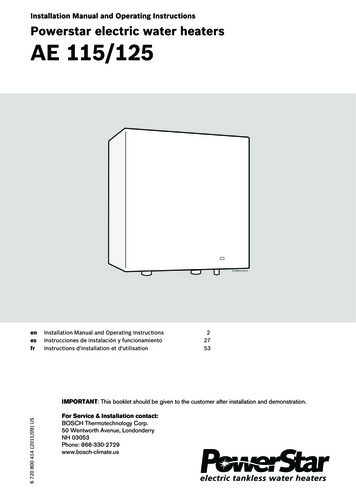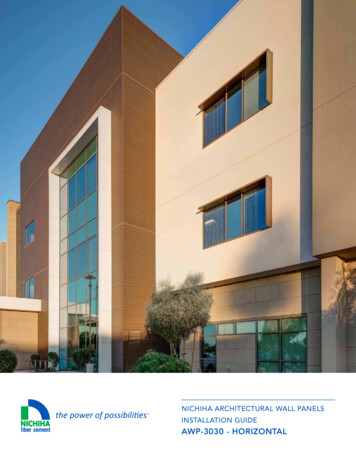
Transcription
NICHIHA ARCHITECTURAL WALL PANELSINSTALLATION GUIDEAWP-3030 - HORIZONTAL1
NICHIHA INSTALLATION GUIDE FOR AWP-3030 - HORIZONTALNICHIHA ARCHITECTURAL WALL PANELSGENERALINSTALLATION GUIDEAWP-3030 - HORIZONTALTABLE OF CONTENTSBasics3Limitations, Technical Reviews, SpecialApplicationsSafetyFraming & SheathingContinuous InsulationWeather Resistive BarriersStorage & HandlingFastenersHardware & AccessoriesPlanning & Layout24456667810Installing the Starter Track11General Panel & Accessory BasicsPanel SelectionSealing Cut Panel EdgesCutting Ultimate ClipsFinish Clip UsageSealantSealant Joints/Caulking12121213141515Panel InstallationStructural Insulating PanelsPre-Engineered Metal Buildings161717Inside Corners, Windows, & DoorsInside CornersWindow SillsWindow/Door JambsWindow/Door HeadersOutside Corners181819202122Vertical Control/Expansion Joints25Horizontal/Compression Joints26Garage Doors & Other Openings27Penetrations, Railings, & Signage27Last Course28Gable & Overhang28Sloped Grade/Panels Below29Cleaning Panels30Paint Touch-Up30Removal of Exterior Acrylic Latex Paint30Other Paint & Graffiti Removal31Repairing Minor Damage31Panel Replacement32This guide is intended to provide the keyinformation needed to successfully installNichiha’s 3030mm Architectural Wall Panels(AWP-3030) horizontally. Further installationinformation and technical resources such asTechnical Bulletins, animated instructionalvideos, three-part speciications, producttesting and certiications, architecturaldetails in AutoCAD, Revit, and PDFversions, and other technical documentsare available on our website:Nichiha.com/resources.Install products in accordance with thelatest installation guidelines and allapplicable building codes and other laws,rules, regulations and ordinances. Reviewall installation instructions and otherapplicable product documents beforeinstallation.PRODUCT INSPECTIONInspect all products thoroughly priorto installation. Do not install anyproduct which may have been damagedin shipment or appears to have adamaged or irregular finish. Shouldyou have a question or problem withyour order, contact your local dealer orNichiha Customer Service, toll-free, at1.866.424.4421. Keep the products dryprior to installation. It is best to storethe products indoors.
BASICS OF THE AWP-3030 SYSTEMNichiha AWP-3030 dimensions are 455 mm (h)x 3,030 mm (l) x 16 mm (t). It is important tokeep in mind the actual metric dimensions whenconsidering panel layout, placement of controland compression joints, and with respect tosizing window and door openings. ApproximateImperial dimensions are 17-7/8 inches (h) x 1195/16 inches (l) x 5/8 inch (t).AWP-3030 edges are ship-lapped on the topand bottom and a factory sealant gasket isincluded on the top edge, providing a factoryseal on all horizontal joints. AWP attachmenthardware engages the top and bottom paneledges, holding the panels off the substratesurface by 10 mm ( 3/8”) and creating a closedjoint, drained/back-ventilated rainscreen systemwith concealed fastening. When accounting forthe overall thickness of the AWP system, add this10 mm plus the thickness of the panel (16 mm)for total system thickness of 26 mm.AWP-3030 may be installed horizontally orvertically. See Installation Guide for AWP3030 - Vertical.Fig. 116mm( 5 8")PANEL FRONT145mm[5-11/16"]8mm[5/16"]455mm( 17-7/8")455mm( 17-7/8")PANEL BACK3030mm[ 119-5/16"]455mm[ 17-7/8"]18mm[ 3 4"]SCALE: 3" 1'-0"VINTAGE WOOD PANEL DETAILSCALE: 1" 1'-0"3
NICHIHA INSTALLATION GUIDE FOR AWP-3030 - HORIZONTALLIMITATIONS, TECHNICAL REVIEWS& SPECIAL APPLICATIONSSAFETYNatural limitations on product usage areinherent to any cladding product’s design,physical characteristics, and attachmentsystem. Nichiha AWP are intended as a lowto-mid-rise cladding product and are not foruse on high-rise buildings. Do not use AWPon open screen walls.As with any natural stone, masonry, orconcrete based product, when cutting,drilling, sawing, sanding, or abrading fibercement cladding, proper safety measuresmust be taken due to the potential forairborne silica dust, an OSHA-identifiedhazardous substance that can pose seriousmedical risks.Any project of more than three stories or45 feet, as well as those located in highwind coastal areas (Exposure Categories Cand D with Basic Wind Speed in excess of130 mph), or those with any wall assemblynot described in Framing & SheathingRequirements, require a technical reviewby Nichiha to evaluate feasibility via ourTechnical Review and Special ApplicationForm (SAF) process.By examining a project’s unique criteria anddesign, we can reference independentlytest-derived and calculated wind loadperformance data for our products todetermine whether and how the panelscan safely be installed on the project.Contact your local rep or Nichiha technicaldepartment for details or to initiate an SAF.AWP are not to be used in any applicationsnot specified or described in this installationguide or other Nichiha technical documents.Do not install AWP on open screen walls orInsulated Concrete Forms (ICFs). Installationof AWP products on modular structuresthat are factory-constructed and thentransported to a final site are not approved;and further, excluded from the LimitedProduct Warranty, per Section 2.F. Any suchuse shall not be backed by product warranty.Please contact Nichiha Technical Services forassistance.4Always wear safety glasses and a NIOSH/OSHA approved respirator with a rating of N,O, or P 100. Carefully follow the respiratormanufacturer’s instructions as well asapplicable governmental safety regulationsconcerning silica. Refer to Nichiha’s SDS formore information.Always cut fiber cement panels outside andwith a dust-collecting HEPA system. Do notcut the products in an enclosed area.Use a dust-reducing circular saw withdiamond-tipped or carbide-tipped fibercement saw blades.Always clean panels after cutting. Fibercement dust can potentially bind to thepanel finish.
FRAMING & SHEATHINGREQUIREMENTSNichiha AWP cladding may be installed onvertical walls only. No tilted/sloped walls,soffits, or ceilings. Wood or steel framing,concrete/masonry with furring, StructuralInsulating Panels (SIP), and pre-engineeredmetal buildings (PEMB) must meet thefollowing requirements:Prior to Nichiha installation, closely inspectexterior wall substrate and correct anyproblems. Walls that are out of plumb,for example, can negatively impact theinstallation quality of AWP. Nichiha Spacermay be used in conjunction with panelattachment hardware if necessary to ensurean even substrate.Structural Insulating Panels (SIP)SIPs should be installed in accordance withmanufacturer’s instructions and local buildingcodes. Additional special Nichiha installationrequirements for SIPs are discussed in theFasteners and Installing the First Coursesections to follow. For buildings greater thanone story, contact Technical Department forassistance.Pre-Engineered Metal Buildings (PEMB)Metal buildings must be new construction.No retrofits/remodels.Refer to PEI-PER 14088 for wind load data.Photo Credit: NucorBuilding SystemsWood StudsSize: minimum 2x4 studsSpacing: 16” o.c maxSheathing: exterior grade minimum 7/16”plywood/OSB (APA rated),½” or 5/8 gypsumMetal StudsGauge: minimum 18Spacing: 16” o.c maxSheathing: exterior grade minimum 7/16”plywood/OSB (APA rated),½” or 5/8”gypsumConcrete/MasonryFurring is required for installation of AWPover concrete and masonry structures.Metal siding/skin deflection of L/120.50 ksi metal panels must have ribs spacedno more than 12” O.C. with metal guagedetermined by allowable wind designpressures:Metal Panel GaugeAllowable Pressure24 gauge-31.41 psf22 gauge-39.29 psfWood Furring: pressure treated lumber 2x4or 5/4x4’s, oriented vertically, spaced 16”o.c. maxProjects with allowable design pressures inexcess of the table values may not utilizeAWP directly over PEMB metal panels.Metal Furring: hat channel, c-stud, or z-furring,minimum 18 gauge with 1-2” langes, orientedvertically, spaced 16” o.c. max.Additional special Nichiha installationrequirements for PEMBs are discussed in theFasteners and Installing the First Coursesections to follow.5
NICHIHA INSTALLATION GUIDE FOR AWP-3030 - HORIZONTALCONTINUOUS INSULATIONSTORAGE AND HANDLINGWhere exterior/continuous insulation is used,AWP may be installed directly over up to1” of foam plastic insulation on wood orgypsum sheathing. Greater amounts requirea structural solution to provide attachmentpoints for AWP such as a furring grid orthird-party specialized system. Mineral woolc.i. of any thickness requires a furring.AWP are a finished product and care mustbe taken to protect them against damageprior to and during installation. Panels mustbe stored flat and kept dry. Refer to storageinformation included on product pallets.Refer to the Technical Bulletin: ContinuousInsulation and AWP available atNichiha.com/resources/technical-bulletins.Please contact Nichiha technical departmentfor further assistance.Ensure panels are completely dry beforeinstalling. Direct contact between the panelsand the ground must be avoided at all times.It is necessary to keep panels clean duringthe installation process.The custom color finish of Illumination Seriespanels requires 30 days to fully cure andextra care must be taken to avoid damage tothe paint during the installation process.Cut panels face down.WEATHER RESISTIVE BARRIERSA weather resistive barrier (WRB) is requiredwhen installing Nichiha panels over studwalls and SIPs. For CMU/concrete wallapplications, we defer to local code. Use anapproved WRB as defined by the 2015 IBC.A breathable WRB is highly recommendedwhen installing Nichiha panels for residentialapplications.A breathable WRB is required for allcommercial applications. A fluid appliedWRB is acceptable.All openings must have appropriate flashingto prevent moisture penetration. Followmanufacturer’s guidelines and all localbuilding codes.6ALWAYS CLEAN PANELS WITH A CLEAN,SOFT, DRY CLOTH AFTER CUTTING. DUSTCAN BIND TO THE FINISH.WHEN SIDEWALKS ARE POURED AFTERAWP INSTALLATION, TAKE STEPS TOCOVER/PROTECT PANELS NEAR GRADE.CEMENT DRIED ON AWP CANNOT BEREMOVED.Fig. 2
FASTENERSALL APPLICATIONSFasteners must be corrosion resistant.Stainless steel or corrosion resistant screwssuch as hot-dipped zinc or ceramic coatedare recommended. Comply with all localbuilding codes for fastener requirements.Number 10 - 16, pan-head screws (HD.365”) were used as clip fasteners for AWPwind load testing. The minimum size for clipfasteners is #8.Number 7 inish screws with a bugle or lat head(min. head diameter 0.255”) are appropriate forface fastening locations. These must penetrateframing per the minimum requirements below.Refer to the Last Course section on page 28for face fastening best practices.WOOD STUDSFasteners must penetrate solid structure aminimum of 1”.STRUCTURAL INSULATING PANELS (SIP)One inch, full-thread, corrosion resistantwood screws must be used.Fasten starter track every 16” max.Double fastening per each Nichiha clip(minimum of 4 screws per JEL777/787 clip)is required as there are fewer or no studs tosecure the system.PRE-ENGINEERED METAL BUILDINGS(PEMB)PEMB wind load/panel gauge table (seeFraming & Sheathing Requirements)contingent upon use of #10-16 x 1” panhead, S/D screws.Fasteners must be spaced at no more than12” o.c. into metal panel ribs.METAL STUDSScrews must penetrate solid structure aminimum of 1/2”.Three threads are needed for effective grab.CONCRETE/ MASONRYFurring to Masonry: Fastener type, size, andspacing to be determined under directionof an engineer and in accordance with localbuilding codes.AWP to Furring: Screws must penetrate woodfurring a minimum of 1” or steel by at least½”.7
NICHIHA INSTALLATION GUIDE FOR AWP-3030 - HORIZONTALINSTALLATION HARDWARE & ACCESSORIESULTIMATE HORIZONTAL STARTER TRACKStarter Track serves as the foundational support for the AWP system whilealso providing faster and greater ease of installation.Horizontal Panels (10’): Starter Track FA 700ULTIMATE CLIPUltimate Clips sit on the panel shiplaps, securing AWP to the wall anddistributing dead loads to the structure. Together, Ultimate Clips andStarter Track hold the back surface of the panels off the substrate to createa 10mm (3/8”) rainscreen space.JEL 777 Clip Compatible with 16mm (5/8”) AWPJoint Tab Attachments included with the Ultimate Clip are not needed withAWP-3030 installations.FINISH CLIP (OPTIONAL)The Finish Clip provides an alternative to face fastening of AWP at certaintermination points where the panel shiplaps are removed. Install over 5mmSpacer. Refer to Finish Clip Usage section for general instructions.JE 310 Finish Clip – Compatible with all AWPCORRUGATED SPACERAt termination points where Panel Clips cannot be used, Nichiha Corrugated Spacer is required to maintain the rainscreen space and prevent paneldeflection at face fastening locations such as window sills and headers.FS 1005 Spacer – 5mmFS 1010 Spacer – 10mm8
SEALANT BACKERSNichiha Sealant Backers provide exact spacing for expansion andtermination joints and the recommended depth of sealant (75-80%).They provide faster installation than a foam backer rod and requireless sealant. At sealant joints, use a sealant that complies with ASTMC920, Class 35 (min.). Refer to the Sealant section on page 15 for moreinformation.Single Flange Sealant Backer: FHK 1015 – 10 mmDouble Flange Sealant Backer: FH 1015 – 10 mmNICHIHA CORNERSNichiha Corners are manufactured mitered panel corners available in thesame finishes as all horizontally oriented AWP. Corners have 3-1/2” returns(face dimension).METAL TRIMNichiha metal trim provides aesthetically pleasing design options forcorners, openings, and transitions, as well as vertical joints.TRIMCorner KeyH-MoldOpen Outside CornerJ-MoldAPPLICATIONSOutside CornersVertical JointsOutside CornersTerminationsESSENTIAL FLASHING SYSTEMStarter*Compression JointOverhang*APPLICATIONSBase/Clearance ConcealmentHorizontal/Compression JointsFascia-to-Soffit Transitions*Inside and outside corner segments are available.9
NICHIHA INSTALLATION GUIDE FOR AWP-3030 - HORIZONTALPLANNING & PANEL LAYOUTTo ensure a successful installation, it isimportant to first plan how the panels willbe laid out, where compression and controljoints will be located, and line of sightregarding inside corners decided.Reminder: AWP-3030 actual dimensions aremetric: 455 mm (h) x 3,030 mm (l). Imperialequivalents: 17-7/8” (h) x 119-5/16” (l).Horizontal/Compression Joints (Page 26): ½”(min.) horizontal, flashed break detail to allowfor building compression at floor lines.Inside Corner Line of Sight (Page 18): Sealantjoints at inside corners can be placed out ofview from the primary line of sight of a wall.Place the sealant joint on the less-viewedcorner wall.Layout: AWP-3030 may only be installed in astacked bond application. Do not stagger.Cut Panels: In general, it is best to avoidcutting AWP to short or narrow strips andsegments of less than 9”. Specifically, whenan individual panel is wider than a window orother opening and is used over the head orunder the sill, do not cut it to less than 9” inheight. (see image A)Vertical Control/Expansion Joints (Pages16 and 25): 10mm (3/8”) sealant jointsthat account for thermal expansion in thelateral dimension. These are often, wherepossible, aligned with window or door jambs,downspouts, or other features in order tominimize their appearance but recur every119-5/16” (max) with AWP-3030. Dependingon sheathing type, additional framing, furring,or blocking may be required at vertical jointlocations.When an opening is wider than an individualpanel and two or more are needed to cap overthe header or cup the sill, do not cut the panelto less than 4” in height. (image B)A9"B104"
AWP-3030:INSTALLING THE FA 700STARTER TRACKALL APPLICATIONSThe Ultimate Horizontal Starter Track (FA 700)must be level and attached at a minimumof 6” above finished soil grade or per localbuilding codes (use a laser level to verify).When installing over a hard surface such asdriveways or sidewalks, a 2” clearance isacceptable.Essential Starter Flashing may be installedprior to the Starter Track to conceal theclearance gap above hardscape and decking.Beginning with outside and inside cornersegments, fasten Flashing at each studlocation or every 10” o.c. to sill plate. FastenFlashing inside and outside corner segmentsto framing on both sides, keeping at least1” from vertical edges. Main segments willslide into/overlap the corner segments. AWP’sbottom face edge will extend ¾” below theStarter Track. Position Flashing and/or StarterTrack to leave 1/4” clearance between thepanel edge and Flashing.Fig. 15The Starter Track must be installed usingcorrosion resistant fasteners. Locate and markthe studs.WOOD & METAL STUDS OR FURRINGStarter Track must be secured at everystud line.CONCRETE/MASONRYWhen installing over concrete construction,the wall must be furred out with pressuretreated lumber or metal hat channel.Starter Track must be secured at eachfurring location.STRUCTURAL INSULATING PANELS (SIP)Secure Starter Track every 16” o.c. max.PRE-ENGINEERED METAL BUILDINGS(PEMB)Fasten Starter Track at every metal panel ribat 12” o.c. max.Essential StarterFlashing11
NICHIHA INSTALLATION GUIDE FOR AWP-3030 - HORIZONTALGENERAL PANEL& ACCESSORY BASICSAll trim, Single and Double Flange SealantBacker should be installed before panels.Refer to Inside Corners, Doors, & Windowsand Vertical Expansion Joints sectionsrespectively.SEALING CUT PANEL EDGESWhen cutting AWP, it is best to cut with thepanel face down, except when cutting brickfinish panels as it is easier to follow thesimulated mortar lines on their face.PANEL SELECTIONNichiha AWP-3030 are packaged with twopanels in a pack, which are placed on palletsconsisting of two stacks. Due to alternatingpatterns of texture and color betweenindividual panels as well as how the panelsare manufactured and packaged, it is best toinstall all panels from each individual stackbefore taking and installing panels from thesecond stack on the same pallet. Do notalternate installing from one stack and thesecond, which may result in undesirablepatterns.Fig. 1612Cut and exposed panel edges mustbe primed or sealed with fiber cementsealer (e.g. DryLock ) or latex paint suchas Kilz Premium or Kilz Max . Do notuse Illumination touch up paint for edgetreatment due to the limited amountprovided. Be sure to clean panels with aclean, dry soft cloth after cutting to preventdust from bonding to the finish.
Fig. 18CUTTING PANEL CLIPSJEL777 Panel Clips are 26” long. Where fulllength clips can be used, they are required.However, there may be conditions whereclips must be cut to accommodate panels orcorner pieces in smaller areas or segmentssuch as narrow columns, pilasters, or insets,recessed openings, or small areas betweenwindows.Notches on the upward panel engagementflanges indicate where clips can be cutevenly into thirds. These 1/3 segmentscan be further reduced evenly into two orfour pieces each with weep holes servingas dividing points. The smallest segmentmust include at least one downward panelengagement flange. Always use the widestclip segment possible.Cut with a non-ferroussaw blade on a band or chop saw.Fig. 1713
NICHIHA INSTALLATION GUIDE FOR AWP-3030 - HORIZONTALFig. 20FINISH CLIP USAGEThe Finish Clip requires added preparation ofthe panels with the use of a biscuit joiner:1. To route grooves into the top edge ofa panel, use a biscuit/plate joiner, suchas Makita’s PJ7000. A carbide blade isrecommended.2. Set the biscuit joiner’s angle guide at zerodegrees and height to ¼”.3. Set the depth of groove for a size 20biscuit to ensure the grooves are wideand deep enough for JE310 clips to seatproperly, ¼” from the back/unfinished faceof the panel.Fig. 214. Route the cut edge with the unfinishedpanel surface facing up, lining the groovesup with stud locations (16” o.c. maximum).5. The clip should fit snug but not too tightlywhen placed on the panel. Cut, routedpanel edges must be sealed with 100%acrylic latex primer or paint. Use 5mmSpacer with JE310 Finish Clips.Fig. 22Fig. 1914"[6 mm]12"[12 mm]PanelFront14PanelBack
SEALANTFig. 23Sealants to be used with AWP must matchthe following requirements: Comply with ASTM C920 Have a Class of 35, 50, or 100/50(minimum 35% joint movement) Be a polyurethane, polyurethane hybrid,or Adfast Adseal 4580 Provide two-sided adhesion at jointsOSI QUAD MAY NOT BE USED FORNICHIHA EXPANSION JOINTS- It is a class 25 product.- QUAD MAX is acceptable since itis a Class 50.Refer to the Technical Bulletin: Sealantsavailable at Nichiha.com/resources/technical-bulletins.SEALANT JOINTS/CAULKINGFasten Single Flange Sealant Backers atinside corners (one wall at corner), alongwindow and door jambs, and transitionpoints with other cladding. Fasten toframing, blocking or plywood/OSB sheathingat 12-14” o.c. with the 3/8” bump/sealantportion butting the corner or jamb.Sealant complying with ASTM C920, Class35 (min.) is required where Single and/orDouble Flange Sealant Backer is used.Refer to the sealant manufacturer’sinstructions or requirements.If excess sealant adheres to panel, removecompletely using a putty knife or soft cloth.Place low-adhesive tape (masking orpainter’s) over the panel along the areasrequiring sealant joints for a clean caulk line.Fill the gap between the panels with acolor-matched/coordinating sealant whichcomplies with ASTM C920, Class 35 (min.)standard. The Nichiha Sealant Backer allowsfor the proper depth of sealant (75-80%).Before removing tape, press the surface ofthe sealant with a caulk spatula or similartool to ensure an even surface. Removemasking tape before sealant cures.15
NICHIHA INSTALLATION GUIDE FOR AWP-3030 - HORIZONTALAWP - 3030 - HORIZONTALINSTALLATIONAWP installation proceeds by working fromleft to right.Wood, Metal, Concrete/Masonrywith FurringFasten the Double Flange Sealant Backerat vertical joints between panels. FastenSealant Backer on right side flange every 1214” to framing, blocking, or plywood/OSBsheathing. (Also see page 25.)For AWP-3030, the left and right paneledges are flat and do not require initialcutting.Install next wall panel right up to the DoubleFlange Sealant Backer and secure with clipsat each stud location. (Figure 26)The panel will fit tightly against an alreadyinstalled inside corner spacer, SealantBacker, or outside corner trim. If startingat an inside corner, predetermine whichwall will include the Single Flange SealantBacker for an inside corner detail. Considerthe location to minimize the visibility of thesealant joint line. Clad the higher visibilitywall without the sealant joint first so that theadjoining wall panels can terminate to it withthe Single Flange Sealant Backer detail.Alternatively, H-Mold metal trim can be usedat vertical joints for horizontal AWP-3030.This trim, as well as Nichiha Sealant Backermust be fastened to plywood/OSB sheathing,framing, furring, or blocking. Fasten metaltrim every 12-16” in a staggered fashion onalternating langes.Set first panel into the Starter Track andsecure the top edge with an Ultimate Clip,placing the first clip about one inch from theleft edge of the panel. Fasten clip at eachstud location the clip reaches. Every clip willcover 2-3 studs and must be fastened toeach. (Figure 24)Verify the first course of panels is level. Largecommercial buildings require checking levelaround the entire building. (Figure 28)Proceed along the panel to the right, placinganother clip 3-4 inches from the end of thepreviously installed clip. DO NOT skip anystuds. Fasten clip at each stud location.Each AWP-3030 long edge must be coveredby four clips. (Figure 25)Since AWP-3030 do not have shiplaps ontheir short edges, a control joint or H-Moldtrim detail is needed at each vertical joint.The vertical joint is continuous and not splitup or staggered.16For H-Mold, leave a 1/8” gap between theedge of the panel and the center lange ofthe trim. (Figure 27)Complete the second and remaining nonterminal rows in the same way. Fit panelstightly together on horizontal joints, ensuringthe panel edges are properly buttedtogether. A rubber mallet or block of woodmay be used to seat the panels firmly inplace and tighten downward.The Joint Tab Attachments are not usedwith AWP-3030. Terminal rows such as underHorizontal/Compression Joints or at the LastCourse are discussed in subsequent sectionsof this guide.
Fig. 24STRUCTURAL INSULATING PANELS (SIP)In general, the steps mirror those for studwall applications. However, double fasteningper each Panel Clip (minimum of four screws,evenly spaced per clip) is required as thereare fewer or no studs to secure the system.There must be four clips per AWP-3030 edge.Fig. 25PRE-ENGINEERED METAL BUILDINGS(PEMB)Refer again to general requirementsconcerning PEMB installations in the Framingand Sheathing Requirements section.With metal panel ribs spaced no more than12” o.c., install AWP in the same manner aswith stud wall applications but with PanelClips fastened to each rib they reach. Screws(#10 x 1”) applied at no more than 12” o.c.Fig. 26There must be four clips per AWP-3030 longedge.Fig. 27Fig. 2817
NICHIHA INSTALLATION GUIDE FOR AWP-3030 - HORIZONTALINSIDE CORNERS, WINDOWS,& DOORSALL APPLICATIONSAppropriate flashing and moisturemanagement best practices must be usedto prevent moisture penetration at all insidecorners, doors, and windows. Refer towindow/door manufacturer requirements andlocal building codes. Cut and exposed paneledges must be primed or sealed with acryliclatex fiber cement sealer or paint.Fig. 293/8" SEALANT JOINT OVER SINGLEFLANGE SEALANT BACKERNICHIHA CLIPINSIDE CORNERSSINGLE FLANGE SEALANT BACKERDecide primary line of sight in order tominimize visibility of the sealant joint.Install the panel on the front wall (morevisible) first. Ensure panel is butted up tightto the inside corner wall. Fasten the SingleFlange Sealant Backer onto the side wallright up against the front wall panel’s edgeat 12-14” o.c.Install side wall panel directly against thesealant backer and secure with Ultimate Clip.Fill space with sealant (Figures 29, 29A,B).TRIM BOARDSNICHIHA PANELFig. 29AInstall trim boards at inside corner first. Thenadd Single Flange Sealant Backer and buttpanel edges to it.Add ASTM C920, Class 35 (min.) compliantsealant to the gap.Fig. 29B18
WINDOW SILLSFig. 30JE310 FINISH CLIPFor recessed windows, add a flashing wherethe panels will terminate so the top edge iscovered or capped at the sill.Remove the top ship-lapped edge of thepanel at the window sill, cutting the panel tothe required height, and route grooves intopanel top at appropriate width to coincidewith framing members. (Refer to Finish ClipUsage for biscuit joiner info.) Clean anydust off the panel. For windows narrowerthan a panel, only remove the portion ofthe panel edge directly under the windowbut accounting for a minimum ¼” gap atboth jambs. Cut, routed panel edges mustbe sealed with 100% acrylic latex primeror paint, such as Kilz Premium or Kilz Max.Panel edge should be spaced a minimum3/8” below a flush or overhanging windowsill to accommodate the Finish Clip.FINISH CLIPOVER 5MM SPACERFasten FS1005 Corrugated Spacer (5mm)at stud locations before setting panel intoplace.Seat Finish Clips into grooves and fasten ateach stud location, through Spacer, to securepanel into place. (Figure 30)If the top edge of the panel is fully shelteredunder the sill, it is not necessary to seal the3/8” gap. For better system performance,Nichiha recommends the vented approach.19
NICHIHA INSTALLATION GUIDE FOR AWP-3030 - HORIZONTALFACE FASTENING(J-MOLD OPTIONAL)For recessed windows, add a flashing wherethe panels will terminate so that the topedge is covered or capped at the sill.As needed to match the window width,remove panel top ship-lapped edge, cuttingthe panel to the required height to fit belowthe window sill, leaving a ¼” gap betweenthe top of the cut panel edge and thewindow sill or trim board.Cut, routed panel edges must be sealed with100% acrylic latex primer or paint. Clean anydust off the panel with a clean, soft, drycloth.Add FS1010 Corrugated Spacer (10mm) atstud locations, set the panel on the clips ofthe panel(s) below, and then face fasten top,cut edge of panel at the sill. Keep screws 1”below panel edge. This will avoid crackingor breaking the panel. Best practice is topre-drill the panel before fastening throughlow-adhesive tape applied to panel face tobe removed after patching and touch up.WINDOW/DOOR JAMBSA minimum gap of 1/4” is required whenbutting panels into windows, doors, andtrim boards. Refer to window manufacturerguidelines for spacing trims around windows.SINGLE FLANGE SEALANT BACKER:Install the Single Flange Sealant Backer first,butting to the door/window jamb or trimpieces prior to installing the panels.The Single Flange Sealant Backer must befastened a minimum of 12” to 14” o.c. tostuds, blocking, or structural sheathing.Cut panel to appropriate width. Remember toclean freshly cut panels with a clean, soft, drycloth.Install panels and fill gap with ASTM C920,Class 35 (min.) compliant sealant.Fig. 32Single Flange Sealant BackerIf the top edge of the panel is fully shelteredunder the sill, it is not necessary to sealthe 1/4” gap. Nichiha prefers a ventedapproach.J-Mold or other trim channels can beincluded at a sill but must be placed on thepanel edge prior to face fastening panel sothat the trim is fastened simultaneously.Fig. 31J-MOLD:Pre-install J-Mold trim with a ¼” gapbetween it and the window/door jamb,or per window manufacturer instructions.Panels must fit completely within trim, withno exposed panel edges, but leaving a 1/8”space between panel edge and J-Mold.Lastly, add foam backer rod and sealant tothe ¼” gap between the J-Mold and jamb.20
WINDOW/DOOR HEADERSNICHIHA CORNERS AT RECESSED JAMBS:Nichiha Corners can be used to wraprecessed window jambs. Corners ha
Inside Corners, Windows, & Doors 18 Inside Corners 18 Window Sills 19 Window/Door Jambs 20 Window/Door Headers 21 Outside Corners 22 Vertical Control . the overall thickness of the AWP system, add this 10 mm plus the thickness of the panel (16 mm) for total system thickness of 26 mm.
